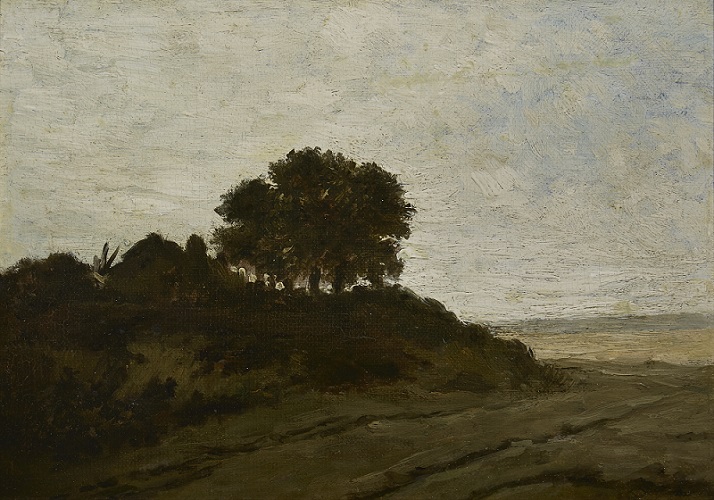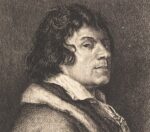
Georges Michel
French, 1763-1843
Landscape, n.d.
oil on panel
14 x 9 7/8 in.
Private Collection

‘Portrait of Georges Michel’, frontispiece to biography by Alfred Sensier, 1873, The National Gallery, London
“These days Montmartre no doubt has those curious effects painted by Michel, for example, i.e., that withered grass and sand against the grey sky. At any rate the color in the meadows at present is often such that one thinks of Michel. The ground yellow, brown withered grass with a wet road with puddles, the tree-trunks black, the sky grey and the houses white, tonal from a distance and yet still having color, in the red of the roofs, for example.” - Letter to Theo, 11 February 1883
COMMENTS
The son of a market employee at Les Halles, Paris, Michel was befriended by a farmer general named M. de Chalue, and in 1775 he began an apprenticeship with the history painter and professor at the Academy of Saint-Luc, Leduc. During the same period, he was also painting and sketching in the open air.
From 1800 he worked at the Louvre as a restorer of Flemish and Dutch paintings, including works by Rembrandt, Jacob van Ruisdael and Meindert Hobbema, all of which had a decisive impact on his own work.
Michel always painted in a small area around Paris, including Montmartre and the plains of Saint-Denis. He became increasingly interested in the dramatic use of light and shade, and his mature work is characterized by stormy skies, broad brushstrokes and vivid contrasts. His paintings had a decisive impact on the Barbizon artists.
https://www.nationalgallery.org.uk/artists/georges-michel
At a period when the painting of the Northern schools was enjoying a revival in France, Georges Michel, according to his widow, carried out some restoration work on Dutch paintings for the influential Paris dealer Jean-Baptiste Pierre Le Brun (1748-1813) and for the Muséum central des Arts (now the Musée du Louvre), at the behest of its director, Dominique Vivant Denon (1747-1825). Even though no trace of this activity can be found in the archives, Michel’s work is incontrovertibly influenced by the masters of the Dutch Golden Age. The exhibition at the Fondation Custodia – one of whose aims is to study the reception of Dutch art in France – takes this opportunity to compare Michel with the predecessors he so admired – and whose work he sometimes copied. From Jacob van Ruisdael (1628/1629-1682) he borrows compositions enlivened by vast, windswept skies, with sometimes a shaft of brilliant sunlight breaking through the clouds. The masterly chiaroscuro in his paintings, however, has its source in the work of Rembrandt (1606-1669). Philips Koninck (1619-1688), whose work in the eighteenth century was sometimes confused with that of Rembrandt, also evidently inspired Michel with his vast landscapes and limitless skies.
https://www.fondationcustodia.fr/Georges-Michel-57
In the letter that launched his campaign, Vincent enclosed a sheet of drawings on which he had labored heroically: a half dozen vignettes of Drenthe life – peasants in the fields, canal banks, village roads - all carefully arranged in a montage exactly like those he had seen in "The Graphic" introducing readers to quaint industries or picturesque locales. When he summoned Theo to paint the moorland skies just as Michel had painted the Montmartre skies, he accompanied the summons with drawings and paintings “in the spirit of Michel”: vistas of brown earth and slate-gray sky. He translated his cries of delight - “What tranquility, what expanse, what calmness in this landscape" - into swirling strokes of clouds and boldly brushed furrows of earth. With nothing more than a pencil, pen, and ink, he showed his brother the serenity that awaited him in a way words never could: a long canal, a barge under sail, a vast pearly dusk.
- Steven Naifeh and Gregory White Smith, Van Gogh: The Life, New York: Random House, 2011, 362-363
SBMA CURATORIAL LABELS
Like so many of the artists that Van Gogh read about and grew to admire, Michel was lionized for his stubborn commitment to replicating nature as seen, no matter how out of step with Parisian taste, as reflected in the exhibition spaces of the annual Salon. Purportedly eccentric, Michel never wavered from his favorite subjects: Montmartre and the plains of Saint-Denis just outside Paris. Most moving for Van Gogh was that Michel died penniless and yet still unremorseful for his dedication to exactly the kind of truth to nature that Vincent grew to venerate.
Like the life of Millet, that of Michel was mythologized by Alfred Sensier in his monograph, published in 1873. The illustrative plates of this book (displayed in the case nearby) were likely Van Gogh’s introduction to Michel’s landscapes and not the paintings themselves. This painting, with its moody palette and stand of silhouetted trees, easily recalls one of Rembrandt’s most famous landscape etchings—and one that Vincent likely knew, exhibited nearby. Michel’s appeal to Van Gogh was likely the consequence of the older artist’s organic fusion of Dutch landscape prototypes—from Rembrandt to Hobbema and Ruisdael—with the suburban views he scouted in daily walks around Paris; routes that Van Gogh also enacted.
- Through Vincent's Eyes, 2022
